Is Same-Day Access the Answer for Long Appointment Wait Times?
- Olivia Hugentobler

- Jan 5, 2023
- 5 min read
A study conducted by JRIM Mental Health in 2022 found that the average wait time for receiving mental health services was around three months from request to first visit. This means that individuals struggling with drug addiction, suicidal thoughts, depression, PTSD, and other urgent issues were asked to wait three months before receiving help, on average.
As a result, many mental health organizations began exploring new ways to ensure quick and efficient access to mental health services when individuals need them most. One suggested solution is termed Same Day Access or SDA. SDA allows a person who calls or appears at a provider during SDA hours of operation to receive access that same day instead of potentially waiting weeks or months for an appointment.
How long does it take to get an appointment in the U.S.?
Throughout the U.S. healthcare system, wait times for appointments are growing. According to a new Merritt Hawkins survey, Americans wait for an average of 28 days or more to get a new patient appointment in 11 major metropolitan areas.
Figure 1 shows that the healthcare industry struggles with long wait times. These metropolitan areas reflect common issues across the United States, with those needing care often being asked to wait months to receive it. It should be noted that these wait times were recorded for non-emergent medical conditions such as exams and do not measure physician availability in urgent care or medical emergency cases.
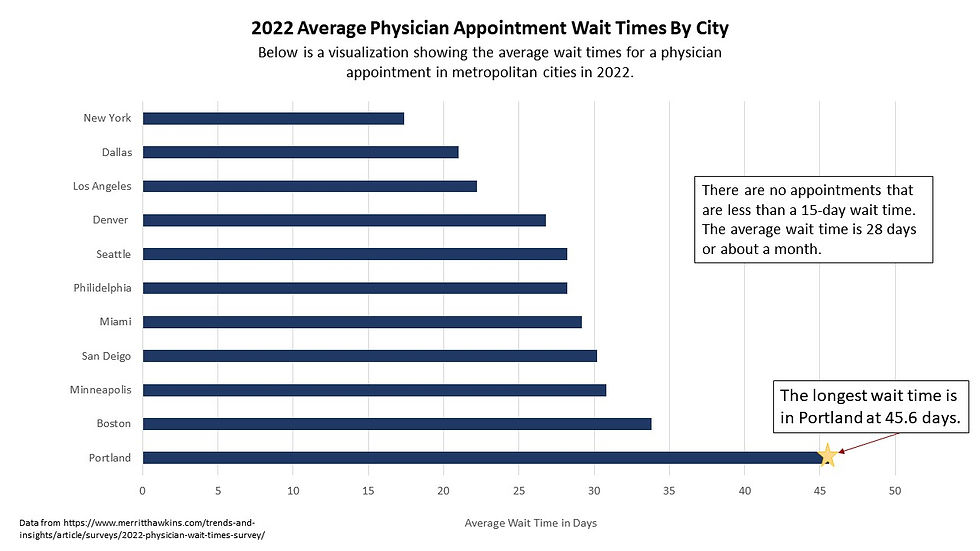
Is this a long-term issue or something new in the healthcare industry? Another study by Merritt Hawkins attempted to answer this question by showing how family medicine doctors' wait times have changed over time in four major metropolitan areas; Philadelphia, Atlanta, Portland, and Dallas.
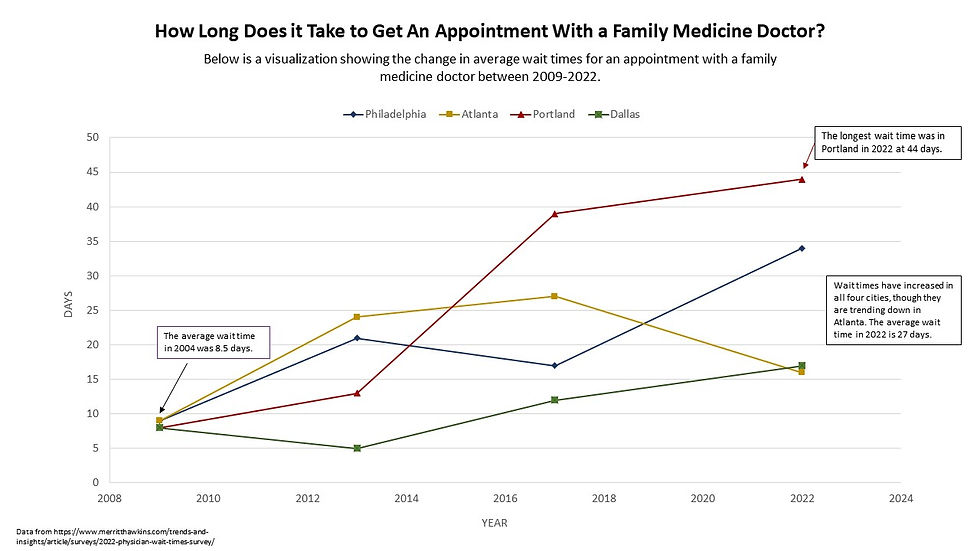
Wait times have increased nearly three-fold since 2009, going from an average of 8.5 days to 27 days, and this is only within family medicine. As demand increases throughout the nation, practices must find a way to ensure patients can obtain an appointment promptly while still providing quality care.
Influence on Behavioral Health
These lengthy wait times haven’t left the behavioral health sector untouched. A study done by JRIM Mental Health in 2022 found that the average wait time for mental health services was around three months. In addition, a survey by the American Psychology Association in 2020 found that many psychologists reported increased demand for care in several areas.
Psychologists reported whether they saw fewer, the same number, or more patients in each area after the COVID-19 pandemic in 2020. Although at least 20% of psychologists reported an increase in each treatment area, the most significant increase seemed to be in anxiety disorders (74%) and depressive disorders (60%).
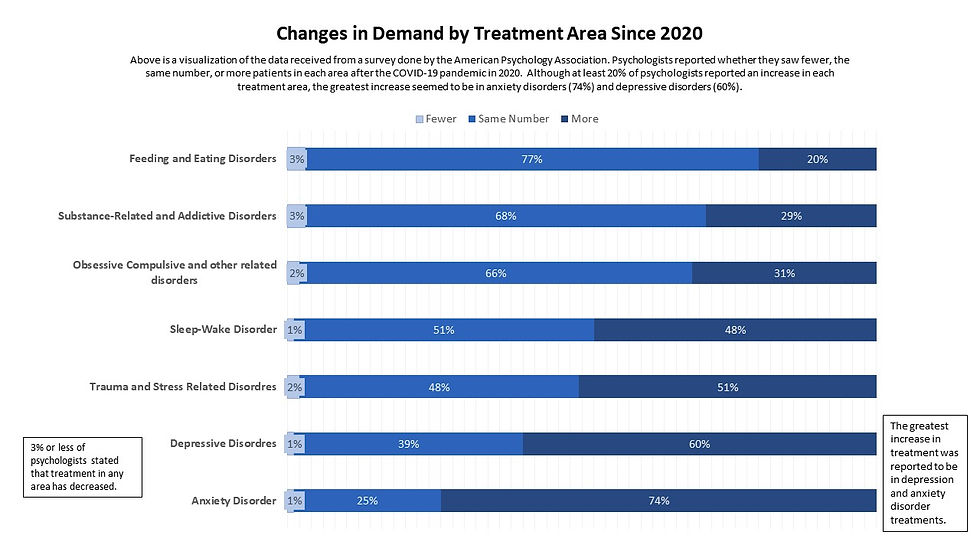
Do Patients Care About Appointment Wait Times?
According to the National Council for Mental Wellbeing, same-day appointments have a 90 percent chance of being kept. In contrast, next-day appointments only have a 75 percent chance of successful attendance. Timely care appeared critical to patients and a deciding factor when patients choose where to seek care and if they follow through with their care.
Kyruus Solutions surveyed 1,000 patients and asked, “Which of the following will impact your decision about where / from whom you'll obtain care?” Those surveyed could select as many answers as applied to their situation. The following figure shows a visualization of the top five results.
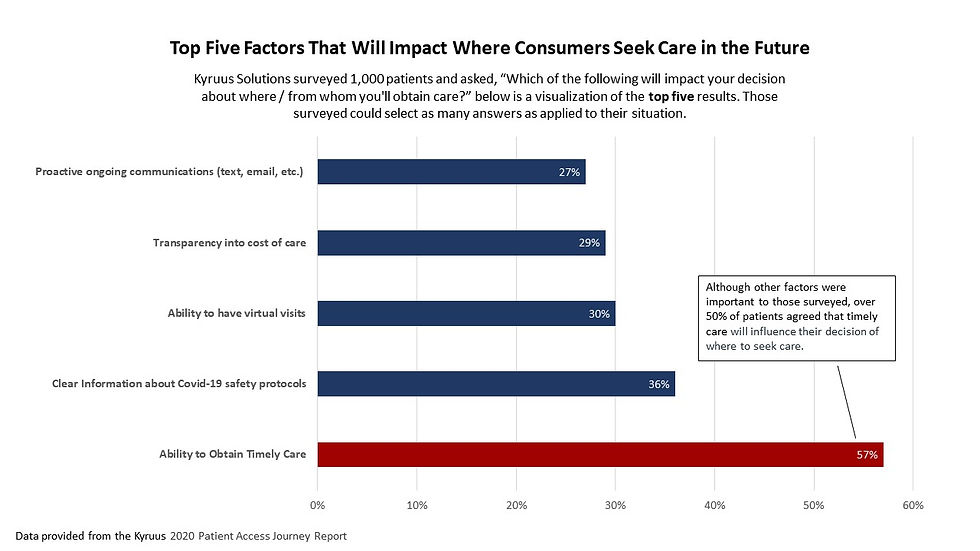
More than half of the 1000 patients surveyed said that the ability to obtain timely care would influence where they chose to seek care in the future. This is important for healthcare providers looking to increase caseloads, provide greater care, and encourage attendance and improved outcomes. Lengthy wait times seem to discourage better care, and patients will seek a provider who can guarantee care sooner and more efficiently.
The Solution: Same-Day Access
Same Day Access (SDA) allows a person who calls or appears at a provider during SDA hours of operation to receive access that same day instead of potentially waiting weeks or months for an appointment.
Essentially, SDA changes how clinics do their scheduling. In traditional scheduling models, the provider arrives at the office daily to a full schedule. Not just full, it's saturated, and each patient on the schedule made an appointment a month ago (or sometimes several months ago). Urgent cases are squeezed in by double-booking, skipping lunch, working late, or running behind.
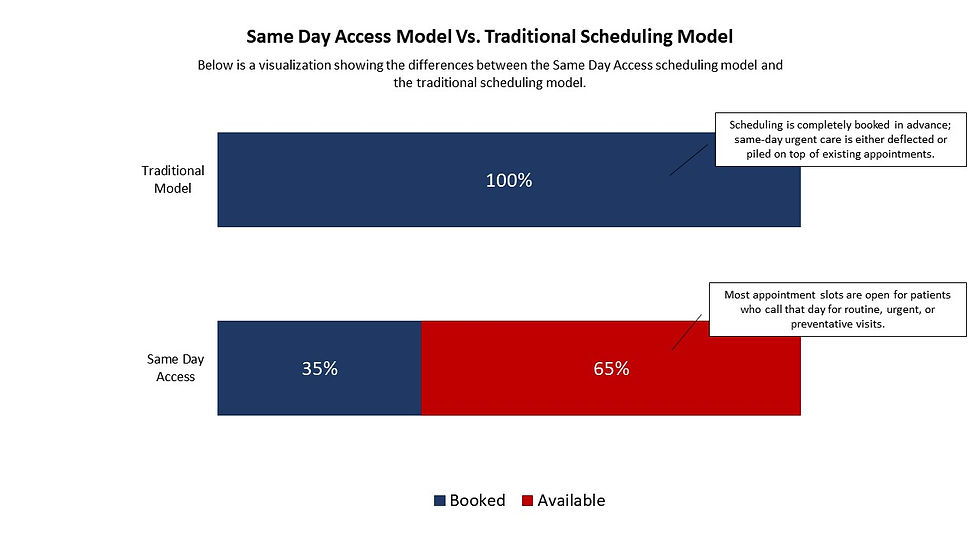
Same Day Access could be the answer to an overwhelming scheduling system, but it requires a paradigm shift. To succeed, physicians must suspend what they have traditionally thought about scheduling. In health care, it is genetically encoded that, “if you are really sick, we will see you today; if you are not really sick, you can wait.” Same-Day Access eliminates the distinction between urgent and routine and requires that practices, “do all of today’s work today.” It opens up most of the schedule for same-day appointments but still allows room for future appointments to meet patients’ scheduling needs.
Is Same Day Access Successful?
Same-Day Access seems great in theory, but does it work in reducing patient wait times in practice? The American Academy of Family Physicians (AAFP) conducted a study to measure the success of same-day access in four of their clinics: the Keiser Permanente clinic, The Mayo Clinic, the Alaska Native Medical Center, and the Fairview Red Wing Clinic. They recorded the average wait time of each clinic every six months for one year.
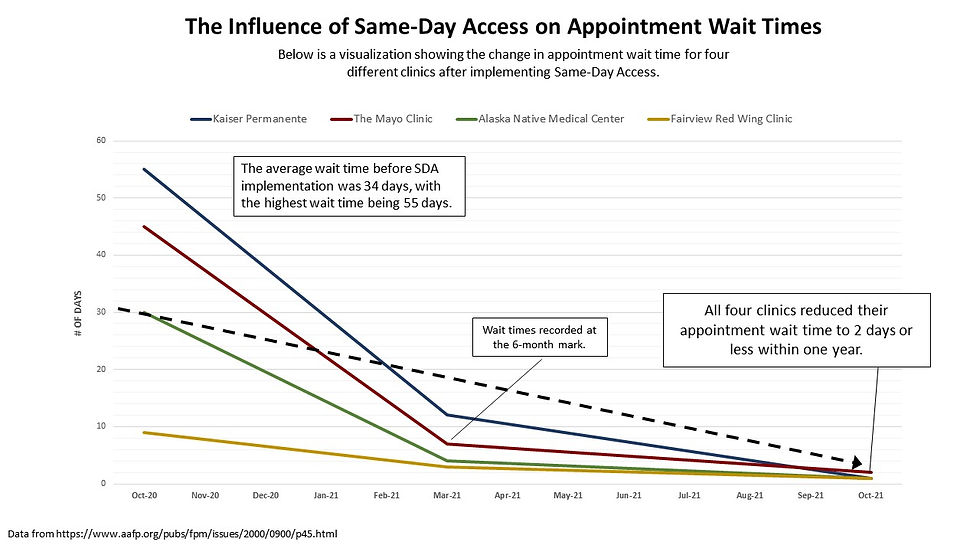
At the beginning of the year, the average wait time for a behavioral health appointment was 34 days, with the highest wait time being 55 days at the Kaiser Permanente clinic. After the implementation of Same Day Access, all four clinics reduced their wait time to two days or less.
Pinnacle Health Informatics has assisted several clients with the implementation of SDA. One of our clients came to us hoping to see the results of this effort. We collected the agency’s average wait time each month to see how they changed over time. The results are shown below.
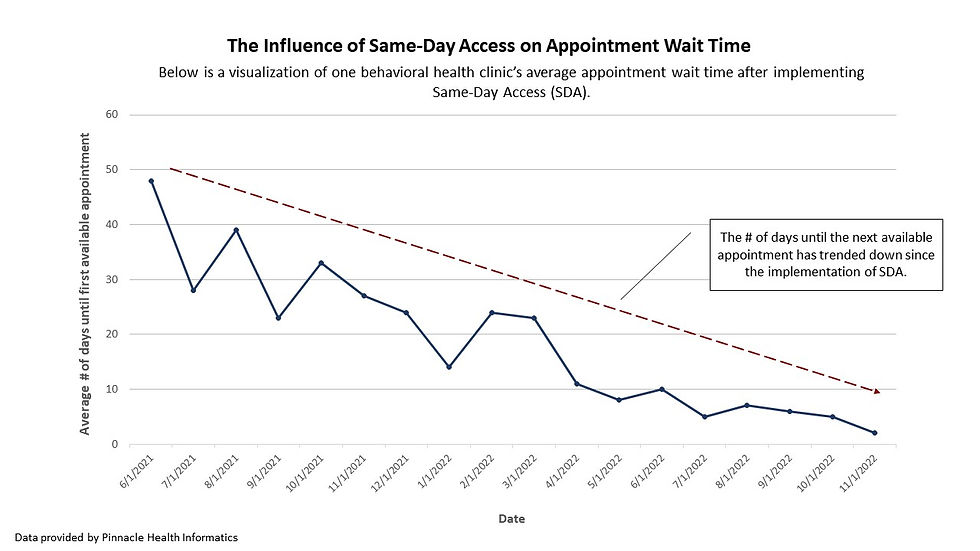
In one year, the clinic was able to get their appointment wait times from 48 days to two days or less. Patients with non-urgent issues could receive needed care without overwhelming staff or waiting months for an appointment. In short, by implementing effective SDA monitoring and tracking the results through data visualization, the wait times for mental health services have significantly decreased.
SDA decreased appointment wait times significantly. However, that was not the only benefit of this shift. With the clinics studied by the AAFP, there was an increase in patient, staff, and provider satisfaction, as well as an increased percentage of patients who matched with their own physicians.
With all four clinics, the implementation of SDA decreased appointment wait times significantly. However, that was not the only benefit of this shift. With the clinics studied by the AAFP, there was an increase in patient, staff, and provider satisfaction, as well as an increased percentage of patients who matched with their own physicians.
Implementing Same-Day Access
Effective data monitoring tools, such as dashboards and data visualizations, are essential to implementing SDA. These data tools help an agency monitor performance and correct issues that may arise in implementing Same Day Access. In addition, SDA visualizations can give deep insight into patient population behavior and SDA efforts.
Same Day Access Practices, when applied effectively, can greatly benefit the client population and help agencies utilize resources more effectively. When data is combined with effective visualizations and business intelligence tools, stakeholders at all levels can affect positive change more quickly and help patients achieve better outcomes. Pinnacle Health Informatics can help your organization achieve these outcomes.
Patients deserve timely care, and providers should not be overwhelmed and stretched thin. Same-day access could be the solution your organization has been looking for. When practices are given the tools to implement same-day access, appointments cease to be scarce, demand decreases, and visits become more productive. Clinics discover more capacity in their system than they initially thought possible. This creates the opportunity to spend more time on practice management, patient education, teaching or seeing more patients, and growing the practice, not months into the future but today.
Learn more about how we can assist you in implementing Same-Day Access with a free consultation.







Comments